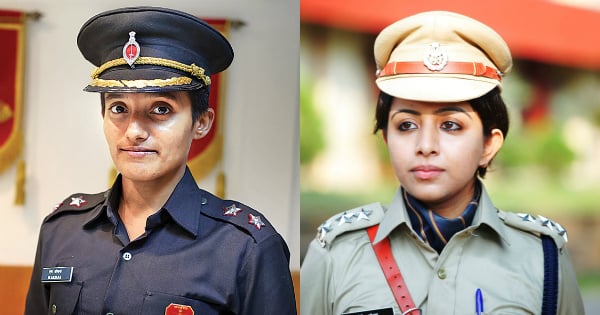There has been a lot of resistance from the defence forces officers after the October 2016 MoD letter which downgraded the rank status of defence officers as compared to their civilian and IPS counterparts.
How To Prepare for SSB Interview:
There can be many criteria for obtaining equivalence between the services of India such as pay scale, functioning, status, etc. If going with pay scale, military officers have an upper hand due to the extra allowance to them as Military Service Pay (MSP) when compared to IPS and Civil Service officers.
Equivalence according to 7th CPC:
The equivalent ranks between Tri-Services, Civil Services and IPS according to their pay scale are as follows:
| CAPFs Ranks | Police Ranks | Army Ranks | Navy Ranks | Air Force Ranks | Coast Guard Ranks. |
| Director General (Apex Scale of the Indian Police Service) | C.P, Director General of a State Police Force | Lieutenant General (Army Commander’s Scale) | Vice Admiral (FOC-in-C’s Scale) | Air Marshal (AOC-in-C’s Scale) | Director General |
| Special Director General (HAG+ scale of Indian Police Service) | C.P, Special Director General | Lieutenant General(HAG+ Scale) | Vice Admiral(HAG+ Scale) | Air Marshal(HAG+ Scale) | Additional Director General (HAG+ Scale) |
| Additional Director General (HAG Scale of the IPS cadre, also available to BSF cadre) | C.P, ADG | Lieutenant General (HAG) | Vice Admiral(HAG) | Air Marshal(HAG) | Additional Director General (HAG Scale) |
| Inspector General | Joint C.P, IG | Major General | Rear Admiral | Air Vice Marshal | Inspector General |
| Deputy Inspector General | Additional C.P, DIG | Brigadier | Commodore | Air commodore | Deputy Inspector General |
| Commandant | DCP(Selection grade)/SSP | Colonel | Captain | Group Captain | commandant |
| 2 I/C | DCP(Jr grade)/SP | Lt.Colonel | Commander | Wing Commander | commandant (Jr grade) |
| Deputy Commandant | Addl.DCP/Addl.SP | Major | Lt.Commander | Sqn Leader | Deputy Commandant |
| Assistant Commandant | Assistant Commissioner of Police/ Deputy Superintendent of Police | Captain | Lieutenant | Flight lieutenant | Assistant Commandant |
| Level 10 | Lieutenant | Assistant SP | Assistant collector |
| Level 10A | Captain | Addl.SP | Sub Collector |
| Level 11 | Major | SP | Collector |
| Level 12/12A | Lt. Colonel | SP | |
| Level 13 | Colonel | SP | Collector(selection grade) |
| Level 13A | Brigadier | DIG | – |
| Level 14 | Major General | IG | Secy(state govt.) |
| Level 15 | Lt. Gen(HAG) | ADGP | Principal Secy(state govt.) |
| Level 16 | Lt Gen(Corps Commander) | DG (HAG+) | Addl. Chief Secretary/Spl. Chief Secretary |
| Level 17 | Lt Gen(Army Commander) | DGP (HoPF) | Chief Secretary |
| Level 18 | General | – | Cabinet Secretary |

Far from Reality:
These equivalence are far from reality. Because if the pay scale were to be considered, defence officers get extra Military Service Pay that makes them superior to their IPS and Civil counterparts, which is clearly not the case.
Also, the time frame for promotion of IAS officers were not reduced. This basically means that an IAS officer, after 14 years of service, would be granted the pay-scale of a Maj Gen, having 33 years of service. While this does not mean that an IAS officer with 14 years of service becomes equivalent in status to a Maj Gen, since only those IAS officers in the super time scale who are empanelled and holding posts of Joint Secy to Govt of India can be equated with a Maj Gen, still the monetary package granted to IAS officers with 14 years of service would be the same as Major Generals.
Also, since the Cabinet Secretary is the highest civil servant of India, his status is higher than the General of Indian Army.
The Correct Equivalence – The Order of Precedence:
The correct equivalence however, only virtually exists. The status of various officer holders are given below in the decreasing order of precedence. And this defines their status equivalence in All India Services. This means that person below the status of preceding person must salute/greet the person with higher status:
| Rank | Officer |
| 1 | President |
| 2 | Vice-President |
| 3 | Prime Minister |
| 4 | Governors of States |
| 5 | Former Presidents |
| 5A | Deputy Prime Minister |
| 6 | Chief Justice Speaker of the Lok Sabha |
| 7 | Cabinet Ministers of the Union Chief Ministers of States Deputy Chairman of the NITI Aayog Former Prime Ministers Leaders of the Opposition in the Rajya Sabha and the Lok Sabha |
| 7A | Holders of the Bharat Ratna |
| 8 | Ambassadors Extraordinary and Plenipotentiary and the High Commissioners of Commonwealth countries accredited to India Chief Ministers of States (when outside their respective States) Governors of States (when outside their respective States) |
| 9 | Judges of the Supreme Court of India |
| 9A | Chairman, Union Public Service Commission Chief Election Commissioner Comptroller and Auditor General |
| 10 | Deputy Chairman of the Rajya Sabha Deputy Chief Ministers of States Deputy Speaker of the Lok Sabha Members of the NITI Aayog Ministers of States of the Union |
| 11 | Lieutenants Governor of Union Territories (within their respective Union Territories) Attorney General Cabinet Secretary |
| 12 | Chiefs of Staff holding the rank of full General or equivalent rank |
| 13 | Envoys Extraordinary and Ministers Plenipotentiary accredited to India |
| 14 | Chief Justices of States Chairmen and Speakers of State Legislatures (within their respective States) |
| 15 | Chief Ministers of Union Territories (within their respective Union Territories) Cabinet Ministers in States (within their respective States) Chief Executive Councillor of Delhi (within their respective Union Territories) Deputy Ministers of the Union |
| 16 | Officiating Chiefs of Staff holding the rank of Lieutenant-General or equivalent rank |
| 17 | Judges of High Courts, Chairman, Central Administrative Tribunal Chairman, Minorities Commission Chairman, Scheduled Castes and Scheduled Tribes Commission |
| 18 | Cabinet Ministers in States (outside their respective States) Chairmen and Speakers of State Legislatures (outside their respective States) Chairman, Monopolies and Restrictive Trade Practices Commission Deputy Chairmen and Deputy Speakers of State Legislatures (within their respective States) Ministers of State in States (within their respective States) Ministers of Union Territories and Executive Councillors of Delhi (within their respective Union Territories) Speakers of Legislative Assemblies in Union Territories Chairman of Delhi Metropolitan Council (within their respective Union Territories) |
| 19 | Chief Commissioners of Union Territories not having Councils of Ministers (within their respective Union Territories) Deputy Ministers in States (within their respective States) Deputy Speakers of Legislative Assemblies in Union Territories Deputy Chairman of Delhi Metropolitan Council (with in their respective Union Territories) |
| 20 | Deputy Chairmen and Deputy Speakers of State Legislatures (outside their respective States) Ministers of State in States (outside their respective State) |
| 21 | Members of Parliament |
| 22 | Deputy Ministers in States (outside their respective States) |
| 23 | Secretaries to Government of India Army Commanders/Vice Chief of the Army Staff or equivalent in other Services Chief Secretaries to State Governments (within their respective States) Commissioner for Linguistic Minorities Commissioner for Scheduled Castes and Scheduled Tribes Members, Minorities Commission Members, Scheduled Castes and Scheduled Tribes Commission Officers of the rank of full General or equivalent rank Secretary, Minorities Commission Secretary, Scheduled Castes and Scheduled Tribes Commission Secretary to the President Secretary to the Prime Minister Secretary, Rajya Sabha/Lok Sabha Solicitor General Vice-Chairman, Central Administrative Tribunal |
| 24 | Lieutenant Generals Air Marshals Vice Admirals |
| 25 | Additional Secretaries to Government of India Advocate Generals of States Additional Solicitor Generals Chairman, Tariff Commission Charge Affairs and Acting High Commissioners a pied and ad. interim. Chief Ministers of Union Territories (outside their respective Union Territories) Chief Executive Councillor of Delhi (outside their respective Union Territories) Chief Secretaries of State Governments (outside their respective States) Deputy Comptroller and Auditor General Deputy Speakers of Legislative Assemblies in Union Territories Chairman of Delhi Metropolitan Council (outside their respective Union Territories) Deputy Chairman of Delhi Metropolitan Council (outside their respective Union Territories) Director of the Intelligence Bureau Director, Central Bureau of Investigation Director-General, Border Security Force Director-General, Central Reserve Police Force Lieutenants Governor of Union Territories (outside their respective Union Territories) Members, Central Administrative Tribunal Members, Monopolies and Restrictive Trade Practices Commission Members, Union Public Service Commission Ministers of Union Territories and Executives Councillors of Delhi Principal Staff Officers of the Armed Forces of the rank of Major General or equivalent rank Speakers of Legislative Assemblies in Union Territories |
| 26 | Joint Secretaries to Government of India Major Generals Rear Admirals Air Vice Marshals |
Conclusion:
It is very hard to define exact rank equivalence of defence officers with their other counterparts as there are many criterion to be considered. However, the one that should be followed is the order of precedence that defines the status of the personnel in the order.





